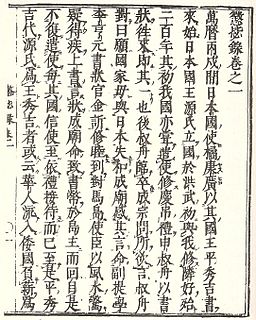 W
WThe Japanese invasions of Korea of 1592–1598 or Imjin War involved two separate yet linked invasions: an initial invasion in 1592, a brief truce in 1596, and a second invasion in 1597. The conflict ended in 1598 with the withdrawal of Japanese forces from the Korean Peninsula after a military stalemate in Korea's southern provinces.
 W
WGoddess of Fire is a 2013 South Korean television series starring Moon Geun-young, Lee Sang-yoon, Kim Bum, Park Gun-hyung, Seo Hyun-jin, Jun Kwang-ryul, Jeong Bo-seok, Byun Hee-bong, Han Go-eun, and Lee Kwang-soo. It aired on MBC from July 1 to October 22, 2013 on Mondays and Tuesdays at 21:55 for 32 episodes.
 W
WThe Jingbirok, written in Hanmun, is a first hand account of the Imjin War written by high ranking Joseon scholar-official Ryu Seong-ryong. Party to high level decision making on the allied Ming-Joseon side and able to access all Joseon records, Ryu Seong-ryong's Jingbirok has become an invaluable source in the study of the conflict, and Chinese-Korean-Japanese relations. In 1969 the Jingbirok was listed as the 132nd of the National Treasures of South Korea.
 W
WThe Mimizuka , an alteration of the original Hanazuka is a monument in Kyoto, Japan, dedicated to the sliced noses of killed Korean soldiers and civilians as well as Ming Chinese troops taken as war trophies during the Japanese invasions of Korea from 1592 to 1598. The monument enshrines the severed noses of at least 38,000 Koreans killed during Toyotomi Hideyoshi's invasions. The shrine is located just to the west of Toyokuni Shrine, the Shinto shrine honoring Hideyoshi in Kyoto.
 W
WNose tombs are tombs that contain human noses or other body parts that were brought back to Japan as trophies during the Japanese invasions of Korea in the late 16th century.
 W
WSuncheon Castle, also known as Suncheon Waeseong, in Korean, Juntenjō (順天城) in Japanese, is the only remaining Japanese castle in Jeollanam-do, and the battlefield of Yi Sun-sin who tempted Konishi Yukinaga from here to Noryang Point known as Battle of Noryang Point.
 W
W W
WUlsan Castle, also known as is a Japanese style castle in Ulsan, South Korea which was constructed during the Japanese invasions of Korea by Katō Kiyomasa's army. Today, Ulsan Castle is almost ruined by the city planning of Ulsan.